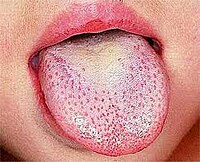
Photo from wikipedia
A novel dual-template magnetic molecularly imprinted polymer (MMIP) was synthesized to extract normetanephrine (NMN), metanephrine (MN) and 3-methoxytyramine (3-MT) from spot urine samples. As the adsorbent of dispersive solid-phase extraction… Click to show full abstract
A novel dual-template magnetic molecularly imprinted polymer (MMIP) was synthesized to extract normetanephrine (NMN), metanephrine (MN) and 3-methoxytyramine (3-MT) from spot urine samples. As the adsorbent of dispersive solid-phase extraction (d-SPE), the MMIP was prepared using dopamine and MN as dual templates, methacrylic acid as the functional monomer, ethylene glycol dimethacrylate as the crosslinking reagent and magnetic nanoparticles as the magnetic core. NMN, MN, 3-MT and creatinine (Cr) in spot urine samples were selectively enriched by d-SPE and detected by HPLC-fluorescence detection/ultraviolet detection. The peak area (A) ratios of NMN, MN and 3-MT to Cr were used for the diagnosis of pheochromocytomas and paragangliomas (PPGLs). The results showed that the adsorption efficiencies of MMIP for target analytes were all higher than 89.0%, and the coefficient variation precisions of intra-assay and inter-assay for the analytes were within 4.9% and 6.3%, respectively. The recoveries of the analytes were from 93.2% to 112.8%. The MMIP was still functional within 14 days and could be reused at least seven times. The d-SPE and recommended solid-phase extraction (SPE) were both used to pretreat spot urine samples from 18 PPGLs patients and 22 healthy controls. The correlation coefficients of ANMN/ACr and AMN/ACr between d-SPE and SPE were both higher than 0.95. In addition, the areas under the receiver operator curves for spot urine ANMN/ACr, AMN/ACr and plasma free NMN and MN were 0.975, 0.773 and 0.990, 0.821, respectively, indicating the two methods had the similar performances. The d-SPE method took only 20 min, which was effective in clinical application.
Journal Title: Molecules
Year Published: 2022
Link to full text (if available)
Share on Social Media: Sign Up to like & get
recommendations!